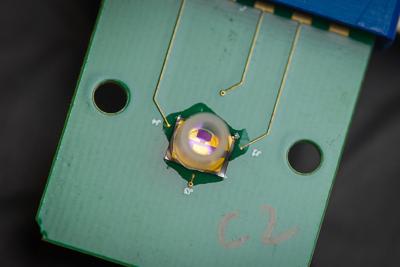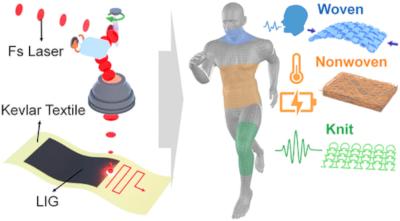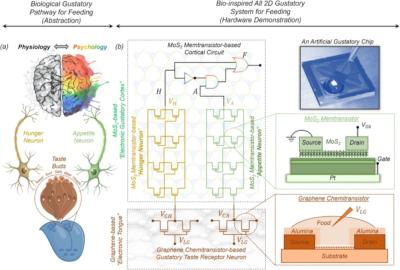Graphene sensors: introduction and market status - Page 4
Zentek launches Triera Biosciences
Canada-based Zentek has announced the launch of Triera Biosciences as its wholly owned subsidiary for its aptamer platform technology. This subsidiary now owns the exclusive, global licensing rights for all aptamer-based technology from the collaboration with McMaster University.
The Company is repotedly taking this action following the strong, consistent pre-clinical results of its universal aptamer as a treatment against the SARS-CoV-2 virus including the latest Omicron XBB 1.5 variant and will continue to build upon its previous work on a rapid detection platform within the new subsidiary. Triera will offer a pure play in the biotech space when operated as an independent business and be more accessible to potential pharmaceutical partners, funders, and other interested parties.
Project Next-2Digits launches for next generation of sensors and imagers
A new Horizon Europe funded project was launched in October 2023. With a consortium of 11 partners from 8 different countries, the Next-2Digits project aims to develop the next generation of sensors and imagers enabled by 2D materials digital integration. Next-2Digits will run for 3 years and 3 months.
Coordinated by the National Technical University of Athens, Next-2Digits benefits from the presence of academic, research and industrial teams, whose areas of work span from graphene and 2D materials synthesis, characterization, manipulation, and integration, as well as in the fields of photonics, material science, application-based integration technologies and validation.
New Horizon Europe project MUNASET launched for graphene-based biosensor platform
A new Horizon Europe project has kicked off called MUNASET. The project will aim to develop a rapid, highly sensitive and easy-to-use graphene-based biosensor platform to address therapy response prediction and allow faster and more precise treatment identification, improve therapy outcomes and reduce hospitalization time. MUNASET will also help secure Europe’s industrial leadership over the entire value chain of novel graphene-based bio-analytical tools.
The MUNASET consortium received funding for over €4 million to cover activities for four years and is under the leadership of Professor Alexey Tarasov, Kaiserslautern University of Applied Sciences. It is composed of six partners across four European countries: Germany, Finland, Belgium and Spain. The consortium members include: Graphenea Semiconductor SL, Johannes Gutenberg University Mainz, VTT Technical Research Centre of Finland Ltd, Mainz University Medical Center and ProActive Ltd. The MUNASET project is a new member of the Graphene Flagship initiative.
Researchers develop DNA aptamer-attached portable graphene biosensor for the detection of degenerative brain diseases
An international team of researchers, including scientists from University of California San Diego, Chinese Academy of Sciences, University of Texas Medical Branch and University of Illinois Urbana-Champaign, has developed a handheld, non-invasive graphene-based device that can detect biomarkers for Alzheimer’s and Parkinson’s Diseases. The biosensor can also transmit the results wirelessly to a laptop or smartphone.
The biosensor consists of a chip with a highly sensitive transistor, made of a graphene layer that is a single atom thick and three electrodes–source and drain electrodes, connected to the positive and negative poles of a battery, to flow electric current, and a gate electrode to control the amount of current flow. Image credit: UCSD
The team tested the device on in vitro samples from patients. The tests reportedly showed the device is as accurate as other state-of-the-art devices. Ultimately, researchers plan to test saliva and urine samples with the biosensor. The device could be modified to detect biomarkers for other conditions as well.
Archer Materials demonstrates multiplexing readout for its Biochip gFET
Archer Materials, a semiconductor company advancing the quantum computing and medical diagnostics industries, has demonstrated multiplexing readout for its advanced Biochip graphene field effect transistor (“gFET”) device.
Archer confirmed single-device multiplexing using four advanced gFETs as sensors, which were integrated into the Archer advanced Biochip platform. This is significant as Archer intends to apply its multiplexing capability in the Biochip to test for multiple diseases on a single chip at once.
Researchers suggest a perovskite-graphene device for X-ray detection
Researchers at Graphenea, University of Utah and Kairos Sensors have examined a perovskite-based graphene field effect transistor (P-GFET) device for X-ray detection.
The device architecture consisted of a commercially available GFET-S20 chip, produced by Graphenea, with a layer of methylammonium lead iodide (MAPbI3) perovskite spin coated onto the top of it. This device was exposed to the field of a molybdenum target X-ray tube with beam settings between 20 and 60 kVp (X-ray tube voltage) and 30–300 μA (X-ray tube current). Dose measurements were taken with an ion-chamber and thermo-luminescent dosimeters and used to determine the sensitivity of the device as a function of the X-ray tube voltage and current, as well as source-drain voltage.
Researchers develop customizable graphene e-textiles
A research team, led by Soongeun Kwon from the Department of Nano Manufacturing Technology at the Korea Institute of Machinery and Materials (KIMM) and Professor Young-Jin Kim from the Department of Mechanical Engineering at the Korea Advanced Institute of Science and Engineering (KAIST), has reported the development of customized graphene-based e-textiles.
Unlike most conventional methods that rely on toxic chemicals or optical masks for patterning, the research team used laser-direct patterning technology to create laser-induced graphene (LIG) on e-textiles. This approach led to the production of graphene-based e-textiles. The team converted raw Kevlar textiles to electrically conductive laser-induced graphene (LIG) via femtosecond laser pulses in ambient air.
Researchers develop unique 'Electronic tongue' using graphene and MoS2
Researchers at Penn State University recently developed an electronic “tongue” and an electronic “gustatory cortex” based on graphene ans MoS2. The artificial tastebuds comprise tiny, graphene-based electronic sensors called chemitransistors that can detect gas or chemical molecules. The other part of the circuit uses memtransistors, which is a transistor that remembers past signals, made with molybdenum disulfide. This allowed the researchers to design an “electronic gustatory cortex” that connect a physiology-drive “hunger neuron,” psychology-driven “appetite neuron” and a “feeding circuit.”
For instance, when detecting salt, or sodium chloride, the device senses sodium ions, explained Subir Ghosh, a doctoral student in engineering science and mechanics and co-author of the study. “This means the device can ‘taste’ salt,” Ghosh said.
Researchers develop graphene-based wearable patch for continuous analysis of biomarkers in sweat
A team of researchers at Penn State has reported the design and fabrication of a long-term stable and highly sensitive flexible electrochemical sensor based on nanocomposite-modified porous graphene by facile laser treatment for detecting biomarkers such as glucose in sweat.
The laser-reduced and patterned stable conductive nanocomposite on the porous graphene electrode provides the resulting glucose sensor with an excellent sensitivity of 1317.69 µA mm−1 cm−2 and an ultra-low limit of detection of 0.079 µm. The sensor can also detect pH and exhibit extraordinary stability to maintain more than 91% sensitivity over 21 days in ambient conditions. Taken together with a temperature sensor based on the same material system, the dual glucose and pH sensor integrated with a flexible microfluidic sweat sampling network further results in accurate continuous on-body glucose detection calibrated by the simultaneously measured pH and temperature.
INBRAIN Neuroelectronics announces FDA Breakthrough Device Designation for Its Graphene-Based Intelligent Network Modulation Platform
INBRAIN Neuroelectronics, a health-tech company dedicated to developing intelligent graphene-neural platform, has announced that its Intelligent Network Modulation System has been granted Breakthrough Device Designation (BDD) from the U.S. Food & Drug Administration (FDA) as an adjunctive therapy for treating Parkinson’s disease.
The INBRAIN system uses graphene, whose electrical and mechanical properties make it ideal for neurotechnology innovation. INBRAIN’s neural platform technology enables ultra-high signal resolution and uses machine learning software that decodes therapy-specific biomarkers to deliver highly focused, adaptive neuroelectronic therapy that re-balances pathological neural networks.
Pagination
- Previous page
- Page 4
- Next page





